Christmas is not traditionally the strongest time of year for luxury watch sales in the UK. Theories vary on why, but there is a broad consensus that the majority of prestige timepieces are not bought as gifts for other people, but for the person that buys it. Compared to summer, there are also fewer affluent tourists around at Christmas, which is a key driver for the top end of the market, particularly in London. For the Christmas period of 2018 GfK has found sales of more expensive watches rising much faster than they were for volume brands — a case of fragile consumer confidence affecting the typical working family more than the upper classes argues Paul Mitchell, senior client insight director at GfK.
Brands and retailers playing in the luxury traditional watch market continue to enjoy robust year on year growth, writes Paul Mitchell, but outside of this, the retail environment remains challenging. The traditional wristwatch market in Great Britain, as tracked by GfK, grew in value by 2.9% in 2018, with December up 3.5% compared to December 2017.
Beyond this topline figure, there remains a clear difference between the mass and luxury markets. Over the full 12 month period, watches selling for £1,000 and above grew in value by 11.4%. At lower prices, markets continued to shrink; value sales below £100 fell by -12.3%, between £100-£500 the market contracted by -15.7% and the £500-£999 price bracket declined by -9.9%.
In the month of December these contrasts were even greater. The run up to Christmas saw sales over £1,000 record a year on year improvement of 17.8%, demonstrating a particularly healthy sector, whilst lower price points continued to struggle.
Gents watches continue to drive high-end growth, with sales up 4.9% over the full year and 5.3% in December. In contrast, Ladies watches declined by -7.2% during the year and were down -5.8% in December. In addition to this, whereas online sales previously represented an area of growth, the overall volume declines in the market are now biting into online sales too, driving value sales in this channel down -3.6% in 2018 and down -1.5% in December.
However, there is still some growth in the online market, with luxury brand sales continuing to develop, but outside of this, one has to search to find any sustained success stories. GfK data shows that Smartwatch sales continue to grow with value up 58% year on year across the GfK Wearables panelmarket, with Connected Watches up 53%.
This, in part, explains the continued decline of the traditional wristwatch market within the mass market, but there are additional factors at play, especially when you consider that the growth of Wearables continues to be off a relatively small base.
One of those factors is consumer sentiment. Across consumer durables we are seeing people buying fewer items, whether they be domestic appliances, consumer electronics or home improvement products. At the same time, those items they are buying are either at the entry level or are more premium, feature rich, products. Driving these trends is the continued uncertainty surrounding Brexit, with consumer confidence in December at its lowest point for 5 years. Such factors certainly contributed to the overall performance of key consumer durables categories (including
Consumer Electronics, MDA, SDA and Telecoms) during Black Friday week when sales were down -2.7% in value and -7.7% in volume year on year. Within Black Friday week there was also a diverging trend between online sales (which were flat) and in store sales (which fell by -6.9% in value).
What is clear is that consumer uncertainly is impacting sales, with retailers reporting very mixed results from Christmas. This, combined with the ongoing decline of the traditional wristwatch mass market, presents a clear challenge for those companies for whom this is their key trading ground. Others, focused on the high end, face a different challenge, sustaining and maximizing sales either through excellence in retail, for Jewellers, or offering a strong brand to consumers, for manufacturers.
 AUTHOR CREDIT:
AUTHOR CREDIT:
Paul Mitchell, Senior Client Insight , Director
paul.mitchell@gfk.com +44 207 890 9045
www.gfk.com/uk/www.twitter.com/gfk_en

